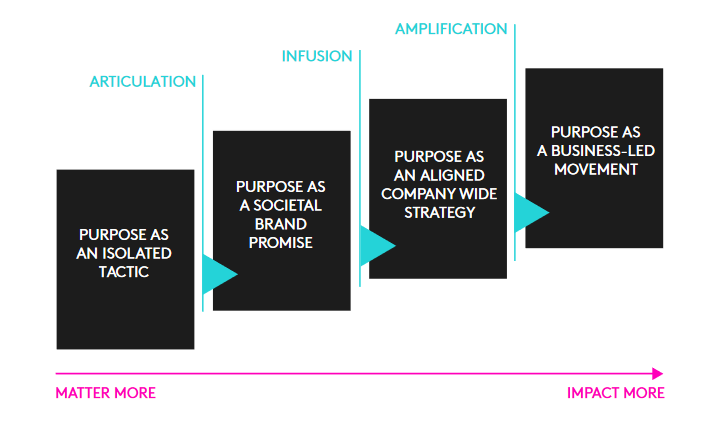MOVEMENT THINKING as an exemplary framework for activating BRAND PURPOSE
Much has been written and said about Brand Purpose in the world of modern marketing. Its importance is evidenced by consumer data, which indicates that when reaching out to brands we are increasingly declaring our desire to support those engaged. For example, in a Weber Shandwick study, 83% of respondents agreed with the statement “It is more important now more than ever to show support for companies that ‘do the right thing’ by buying from them.” Business data also supports its importance. According to Kantar’s 2020 “Inspiring Purpose-Led Growth” report, brands with a strong Purpose component achieve a 175% increase in value over 12 years, while those without it experience only 70% growth. But how do we use Brand Purpose in practice and what is the particular difficulty in its implementation?
Brand Purpose and then what?
Brand Purpose often sounds high-minded and serious. HP, for example, defines its Purpose as creating technologies that make life better – for everyone, everywhere. Ambitious! And that’s good, because Purpose is supposed to be about things that matter, to inspire change in the world in some important area. These are not trivial matters, so a certain amount of pathos is acceptable here, and is perhaps even advisable. Therefore, the Brand Purpose formulated in such a way may be a bit intimidating and it is not a ready recipe for evoking actions leading to the transformation. Defining Brand Purpose is only the beginning of the way, indicating certain intentions. And as we know, in marketing, as in life, there is often a gap between good intentions and taking action which is to put them into practice.
How do you turn good intentions into action?
“If you want to understand how a lion hunts, don’t go to the zoo. Go to the jungle.”
Loosely paraphrasing this famous marketing quote, one could say: if you want to do good, model yourself after those who do it best, for whom it is the fundamental meaning of existence. And with such a proposal come Scott Goodson and Chip Walker proposing “Movement Thinking” – a framework for working on activating Brand Purpose. It is inspired by the way in which social movements work, which stem from the need to do good and the desire to create change in the world. The most powerful social movements have the power to infect people with an idea, to provoke thought that simultaneously leads to commitment to a common goal.
Goodson and Walker are not alone in thinking about activating Brand Purpose by analogy with social movements. Kantar, in the report cited above also uses the term “movement” to describe the highest stage of Brand Purpose implementation in an organization. Starting from the most superficial and single actions, which are rather a declaration of values, up to the full implementation of the approach in the organization, where the defined Purpose becomes a “movement” shaping the business. And only then can we hope to make a real change in the world.

This tight coupling of business and Brand Purpose and not making it a “CSR offshoot” of a company’s activities is becoming more and more common. Antonio Lucio, HP’s Global Chief Marketing & Communication Officer, for example, points out that for them the key to activating Brand Purpose was to answer two questions: what issues in the world today are critical to the survival of their business and their organizational culture? In order to “create technologies that make life better, for everyone, everywhere,” HP chose two pillars that are socially relevant topics on the one hand and relevant to their area of operations on the other. These are sustainability (because this is also relevant from the perspective of achieving the mission of making life better) and the promotion of diversity (as a necessary component to create an environment conducive to innovation). HP’s approach shows one more thing – how important it is to start implementing Brand Purpose inside the organization, by rooting it in the company’s culture, before communicating it to the world.
Movement Thinking Framework
As Goodson and Walker write, it is a framing tool to define a brand’s place in the world and translates Brand Purpose into a simple to understand and motivating call to action. While people may agree with the rightness of Brand Purpose, they can’t join it. Instead, they can join a movement that is inspired by it. Here are 4 key elements used to describe Brand Purpose:
- DISSATISFACTION // What in the surrounding world sparks DISSATISFACTION in the brand? What does the brand complain about and disagree with?
- DESIRED CHANGE // what transformation is the brand willing to fight for? What CHANGE does it want to see in the world?
- ENEMY // What is the brand working against? Who or what is its ENEMY and who and what is it fighting?
- STAND // What does the brand STAND FOR? What stimulates it to undertake the fight to overcome its enemies and bring about the desired change?
An example of how Brand Purpose can directly relate to a brand’s field of action is demonstrated by the application of Movement Thinking to the launch of the Smart car (a joint venture between Swatch and Daimler-Benz). In a world that was becoming increasingly enamored of large cars, resulting in the rapid growth of the SUV segment, Smart had to offer a small, economical car that was environmentally friendly and easy to park. These advantages could have been argued in rational communication. However, the authors of “Movement thinking” decided to make the choice of this brand a concrete statement in the sphere of values. That is why they proposed consumers to join the “Against Dumb” movement, which was about fighting to reclaim more friendly urban spaces that are dominated by big cars. And all in the name of promoting a more conscious approach to consumption.

The trap of purpose washing
The loftiness of Brand Purpose can cause problems in turning it into action, as discussed above. The second big danger is that of the “purpose washing” phenomenon. If we already use big words, they oblige. Great causes require great action, sacrifice, dedication, and determination to see them through. The strongest movements begin within the organization – when a specific Purpose becomes important to the company’s policy, its culture, is a priority for key decision makers. And not just or first the subject of a marketing campaign.

Sources:
https://consulting.kantar.com/wp-content/uploads/2019/06/Purpose-2020-PDF-Presentation.pdf
https://www.warc.com/newsandopinion/news/how-hp-activates-its-purpose/40671
https://www.marketingdive.com/news/study-brands-with-a-purpose-grow-2x-faster-than-others/521693/


